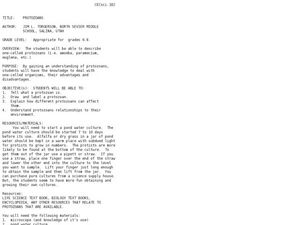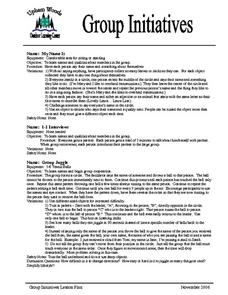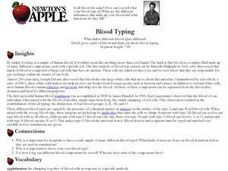American Museum of Natural History
The Tree of Life
Groups of species can have more in common than meets the eye. An interactive cladogram shows some of the connections between important groups of species. Learners click on sections of the diagram to learn more about the connections or on...
Curated OER
Protists
With this collection of slides, future biologists get to view photographs of protozoans from different phyla. Interspersed with the photos are bullet-style notes listing characteristics of each group. Unfortunately, most of the pictures...
Curated OER
Protists and Fungi
In this science instructional activity, students use basic scientific concepts to complete the series of puzzles about protists and fungi that are intended to increase science literacy.
Curated OER
Protect Your Child: Know Your Password
Young scholars practice having a secret password to prepare them for potentially dangerous situations.
Curated OER
Cell Structure and Function
Students discuss scientific advances brought about by the Mars Surveyor Space Program which impact on daily life, identify laboratory apparatus like microscopes, slides and coverslips, and use the microscopes to view cells and organisms.
Curated OER
Things Living in a Pond
Ninth graders observe, compare, and classify various microorganisms using a microscope. They answer discussion questions, and record their observations on a chart.
Curated OER
Protozoans
In this protozoans worksheet, learners observe pond water using a microscope to identify the four classes of single-celled organisms including sarcodines, ciliates, flagellates and sporozoans.
Curated OER
Creating Coacervates
Students create and observe coacervates. In this origin of life lesson, students create coacervates by mixing carbohydrate and protein solutions. They observe the life-like qualities of the structures and discuss the origin of life.
Curated OER
Eukaryotic Cell Structure
In this biology worksheet, students complete 20 fill in the blank questions about eukaryotic cells. They identify the parts and functions of cell organelles.
Curated OER
Discovering the Forgotten Kingdom Protista
Protists, like algae and mold, are sometimes overlooked for classroom study, but they are astonishing in their diversity and importance.
Curated OER
Food Safety Unit Exam 1
Students complete seventeen question test about food safety which includes matching vocabulary terms, short answer questions and fill in the blank questions. Test is part of the Food Safety Unit produced by the College of Agricultural...
Curated OER
Protozoans
Students examine protozoans and their advantages and disadvantages. In this chemistry lesson students explain what a protozoan is then draw and label one.
Curated OER
Group Initiatives
Students explore the names and qualities about members in the group. They each say their name and something about themselves. Students gather around in a circle. They listen to the teacher as he or she says the name of someone and throws...
Curated OER
Protist Crossword
In this protist worksheet, students complete a crossword puzzle with 34 questions about the behaviour and different types of protists.
Curated OER
Inquiry-based Investigations into Pond Water Microorganisms
Students become familiar with common microorganisms and experience exploring the microbial world.
Curated OER
What's Your Type
Students record their blood types on a class graph and calculate the potential number of blood donors for each group.
Curated OER
WHAT IS A CELL?
Students explore the function and structures of cells, including plant and animal cells. They explore cell parts including cell wall, ribosomes, chromosomes, nucleoid, plasmids, flagella, pilli, and plasma membrane, cel
Curated OER
Classy
Students explore the classification system in this seven lessons unit. The diversity of life forms and their characteristics are examined using a microscope. Kingdoms, classes, and families are investigated.
Alabama Learning Exchange
It's a Small, Small World
Middle schoolers compare and contrast the different characteristics of animal-like, plant-like, and fungus-like protists. They list examples and describe the characteristics shared by the three protist groups. They create a brochure or...
Curated OER
Observing Specialized Cells
In this plant and animal cell worksheet, students draw five examples of plant or animal cells that are specialized to perform a particular functions. They also complete 6 short answer questions based on their observations.
Curated OER
Protists
In this protists worksheet, students will use idea maps about plantlike protist and funguslike protist characteristics to complete 4 short answer questions.
Curated OER
What is Biology?
In this science of biology worksheet, learners will review the concepts relating to biology including the characteristics of living things, the process of reproduction, adaptations, and evolution. This worksheet has 5 short answer, 3...
Curated OER
Totally Cellular
In this biology worksheet, students learn about cells and their various parts. They first read a page and a half of facts about cells and then answer the 10 questions in the packet. The answers are on the last page.
Curated OER
Science – How Living Things are Grouped
In this classification of living things activity, students respond to 7 short answer, 10 true or false, 4 multiple choice, and 4 graphic organizer questions regarding how living things are grouped.
Other popular searches
- Amoeba and Paramecium
- Paramecium Euglena Amoeba
- Observing Amoeba
- Paramecium, Euglena, Amoeba
- Amoeba Cells
- Paramecium, Eugenia, Amoeba
- Amoeba Bell Ringer
- Binary Fission Amoeba
- Paramecium Eugenia Amoeba
- Amoeba Dysentery
- Parasitology Amoeba
- Amoeba Endocrine System

























